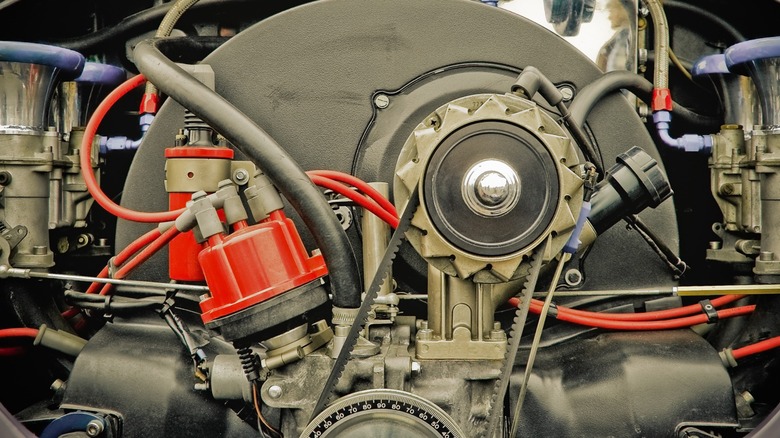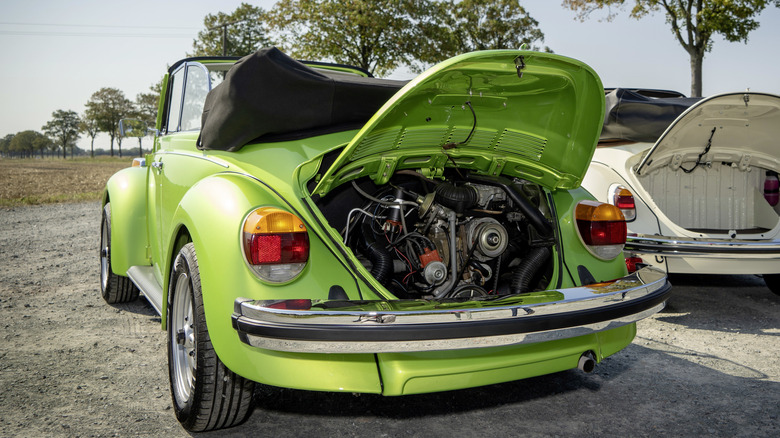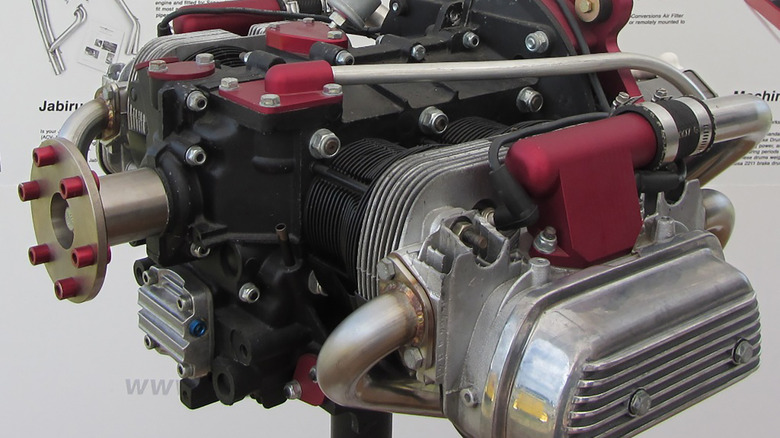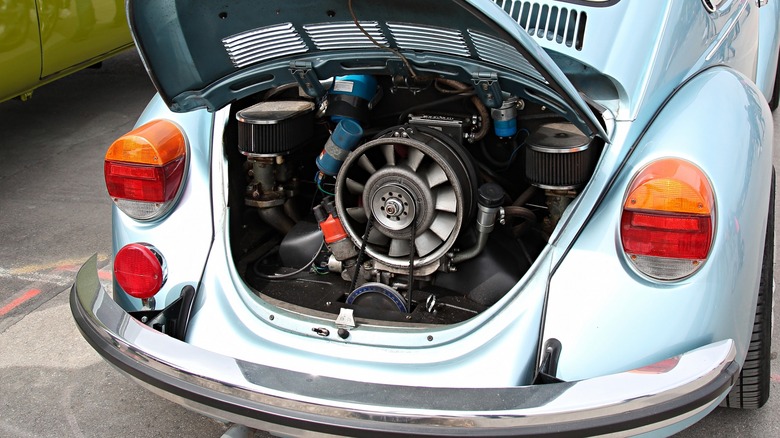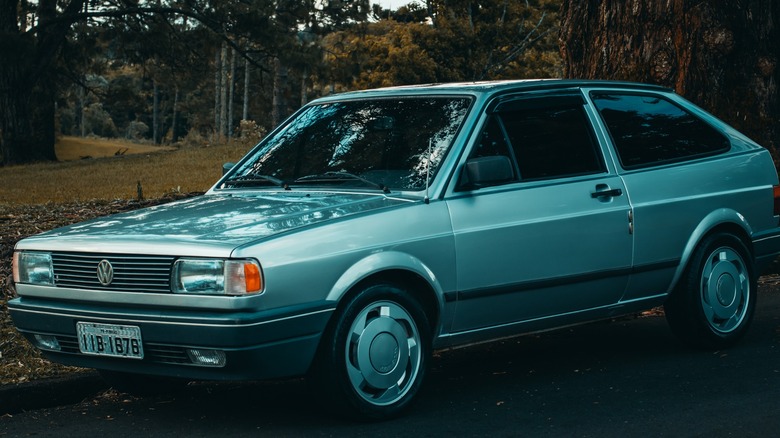An In-Depth Look At Volkswagen's Air-Cooled Flat-4 Engine
Classic Volkswagens have a cult following, and that's certainly no secret. The Type 1 and Type 2, better known as the VW Beetle and Bus, stand out as some of the most recognizable cars in history (though Volkswagen did attempt to replace the Beetle several times). They're staples in movies, commercials, and art and are a common sight at virtually any car show. However, many folks (outside of those who own them) may not know the engines themselves are one of the biggest draws to these particular cars. They are simple, dependable, and easy to work on.
Many folks simply refer to these engines as "flat-four" or "boxer" engines because of their horizontally opposed rotating assembly. While the majority of engines have pistons that oscillate vertically (or near it in the case of V-shaped engines), flat-layout engines have pistons that move side to side from the crankshaft, which is located in the center of the engine block. You'll also hear folks refer to them as "air-cooled" Volkswagen engines because, as the name implies, they do not use a liquid cooling system to maintain operating temperatures. Here's everything you need to know about these iconic powerplants for these legendary cars.
The Birth of Volkswagen's Flat-Four
The recent Volkswagen Superbowl commercial might make you think that the Beetle and the original air-cooled Volkswagen flat-four date back to 1949. That commercial, however, only outlines the history of Volkswagen in the U.S. In reality, the history runs far deeper than that. There are historical ties to some notable personnel in the air-cooled VW's history, for better or worse. One was Ferdinand Porsche and the other was Adolf Hitler.
Ferdinand Porsche wanted to create a car that was affordable and dependable for German citizens attempting to rebuild their lives after The Great Depression. His first break in this dream came from motorcycle manufacturer Zundapp, who was looking to break into the car market. Zundapp hired Porsche to build a prototype and requested a water-cooled radial five-cylinder engine for power. As cool as a miniature airplane-style radial engine for a car sounds, it didn't pan out.
However, that closed window opened another one when Adolf Hitler commissioned Porsche to create his car for the German masses. Porsche's engine designer Josef Kales developed the air-cooled flat-four, which Porsche wanted from the beginning despite the Zundapp radial request. Franz Xavier Reimspiess refined the design work, and, just like that, the iconic "prototype 1" (the basis for what would become the VW Beetle) flat-four engine was born.
Basics of the VW Flat-Four
Though it came with some variation throughout its lifespan, the basic architecture of the air-cooled flat-four remained virtually identical for its entire production run.
The two-piece engine block houses a forged steel crankshaft and a simple four-lobe camshaft. On either side of the engine block are two cylinders and a cylinder head. As mentioned above, the rods and pistons move side to side on either side of the engine block. The crankshaft runs the camshaft with a gear drive, and the valves are controlled by pushrods.
The crankshaft also powers an external generator with a belt, the only belt on the entire engine. The generator powers the vehicle's electrical system and a radial fan that forces air throughout the engine's cylinder barrels and oil cooler to keep the engine at normal operating temperature. Fuel makes its way into the engine via a single carburetor. It's surprisingly uncomplicated as far as engines go.
The engine's remarkable simplicity is undoubtedly one of its desirable attributes that has generated such a cult following. Of course, they're stout and dependable, but they're also extremely easy to work on. It's not recommended, but it's even possible to change the generator belt in a few seconds while the engine is running. While fascinating, it's not recommended, as that technique does present a concerning danger for one's fingers.
[Featured image by FlugKerl2 via Wikimedia Commons | Cropped and scaled | CC BY SA 3.0]
Different Types of the Air-Cooled Flat-Four
The Beetle and Bus were originally known as Type 1 and Type 2 models, as previously mentioned. The engines that power them, though, are also known as Type 1, Type 3, and Type 4 engines. We'll do our best to keep things clear by using familiar model names moving forward in this article.
The Type 1 engine was born with the Beetle. Over the years, it came with a variety of displacements and power outputs: 1200cc, 1,300cc, 1,500cc, and 1,600cc variants of the engine generated either 36 or 40 horsepower in stock format. The only major change to the Type 1 engine was the switch to a dual-port intake system in 1971. It was also used in the VW Bus.
The Type 3 engine is effectively identical to the Type 1 engine except for a different cooling system, exhaust system, and clutch. Because of its flatter cooling system, it's known colloquially as the "pancake" engine.
Finally, the Type 4 engine used bigger diameter pistons and a shorter stroke to expand the displacement as high as 2,000cc by the end of production. The cooling fan mounts directly to the end of the crankshaft, and the cooling and intake system sits low and close to the engine. Because of this, the engine became known as the "suitcase" engine. This engine saw power output as high as 80 horsepower and even found its way into the Porsche 914.
Air-cooled VW Engines Lasted Longer Than You'd Think
The air-cooled VW engine seems like a distant thing of the past to most. That's easy to understand since the Beetle left the U.S. in the 1970s because it didn't meet crash safety standards. However, with over 22 million VW Beetles manufactured worldwide since its beginning, it makes a little more sense that the engine continued its life after it departed from the U.S. market. While the VW Golf and Jetta started to gain popularity stateside, the classics continued their reign overseas.
The original Beetle continued production until 2003 in Mexico. The Bus continued until 2014 in Brazil (called the Kombi) but switched to a water-cooled powerplant in 2005.
Not by coincidence, 2005 was the final year that Volkswagen produced an air-cooled engine. That final engine rolled out of a factory in Sao Paulo, Brazil, on December 23, 2005. It was under the hood of a car called the Volkswagen Gol (not to be confused with the VW Golf). The Gol was the top-selling vehicle in Brazil for 27 consecutive years and continued production until 2022 with water-cooled powerplants.
End-to-end, the Volkswagen air-cooled engine was produced from the 1930s all the way until 2005. That's a pretty impressive run!
